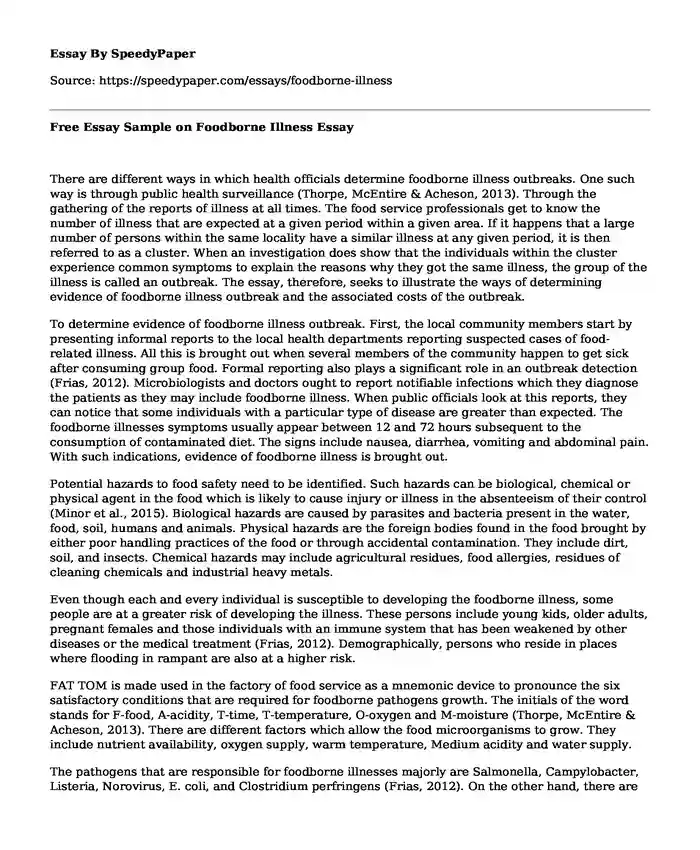
| Type of paper: | Essay |
| Categories: | Health and Social Care Food |
| Pages: | 3 |
| Wordcount: | 648 words |
There are different ways in which health officials determine foodborne illness outbreaks. One such way is through public health surveillance (Thorpe, McEntire & Acheson, 2013). Through the gathering of the reports of illness at all times. The food service professionals get to know the number of illness that are expected at a given period within a given area. If it happens that a large number of persons within the same locality have a similar illness at any given period, it is then referred to as a cluster. When an investigation does show that the individuals within the cluster experience common symptoms to explain the reasons why they got the same illness, the group of the illness is called an outbreak. The essay, therefore, seeks to illustrate the ways of determining evidence of foodborne illness outbreak and the associated costs of the outbreak.
To determine evidence of foodborne illness outbreak. First, the local community members start by presenting informal reports to the local health departments reporting suspected cases of food-related illness. All this is brought out when several members of the community happen to get sick after consuming group food. Formal reporting also plays a significant role in an outbreak detection (Frias, 2012). Microbiologists and doctors ought to report notifiable infections which they diagnose the patients as they may include foodborne illness. When public officials look at this reports, they can notice that some individuals with a particular type of disease are greater than expected. The foodborne illnesses symptoms usually appear between 12 and 72 hours subsequent to the consumption of contaminated diet. The signs include nausea, diarrhea, vomiting and abdominal pain. With such indications, evidence of foodborne illness is brought out.
Potential hazards to food safety need to be identified. Such hazards can be biological, chemical or physical agent in the food which is likely to cause injury or illness in the absenteeism of their control (Minor et al., 2015). Biological hazards are caused by parasites and bacteria present in the water, food, soil, humans and animals. Physical hazards are the foreign bodies found in the food brought by either poor handling practices of the food or through accidental contamination. They include dirt, soil, and insects. Chemical hazards may include agricultural residues, food allergies, residues of cleaning chemicals and industrial heavy metals.
Even though each and every individual is susceptible to developing the foodborne illness, some people are at a greater risk of developing the illness. These persons include young kids, older adults, pregnant females and those individuals with an immune system that has been weakened by other diseases or the medical treatment (Frias, 2012). Demographically, persons who reside in places where flooding in rampant are also at a higher risk.
FAT TOM is made used in the factory of food service as a mnemonic device to pronounce the six satisfactory conditions that are required for foodborne pathogens growth. The initials of the word stands for F-food, A-acidity, T-time, T-temperature, O-oxygen and M-moisture (Thorpe, McEntire & Acheson, 2013). There are different factors which allow the food microorganisms to grow. They include nutrient availability, oxygen supply, warm temperature, Medium acidity and water supply.
The pathogens that are responsible for foodborne illnesses majorly are Salmonella, Campylobacter, Listeria, Norovirus, E. coli, and Clostridium perfringens (Frias, 2012). On the other hand, there are different toxins which cause foodborne illnesses. The illness that results from pathogenic microorganisms is mainly of two types which are intoxication and infection. To avoid foodborne illnesses, it is our responsibility to take greater care of the environment that we live.
References
Frias, M. (2012). Foodborne Illness. Delhi: Research World.
Minor, T., Lasher, A., Klontz, K., Brown, B., Nardinelli, C., & Zorn, D. (2015). The Per Case and Total Annual Costs of Foodborne Illness in the United States. Risk Analysis: An International Journal, 35(6), 1125-1139.
Thorpe, C. M., McEntire, J., & Acheson, D. (2013). Foodborne Illness: Latest Threats and Emerging Issues, an Issue of Infectious Disease Clinics, London: Elsevier.
Cite this page
Free Essay Sample on Foodborne Illness. (2019, Oct 28). Retrieved from https://speedypaper.net/essays/foodborne-illness
Request Removal
If you are the original author of this essay and no longer wish to have it published on the SpeedyPaper website, please click below to request its removal:
- Free Essay on Runaway Slaves of the American Revolution
- Essay Example on Gender Stereotypes in Media
- Multinationals Essay Example
- Enforcing Mental Health Parity: Essay Example with a Journal Article Critique
- Free Paper for Students: Op-ed about Eliminating Cash Bail System in Philadelphia
- Essay Sample on Professional Soccer in the United States
- Free Essay: How Same-Sex Marriage Changed the History of US
Popular categories




